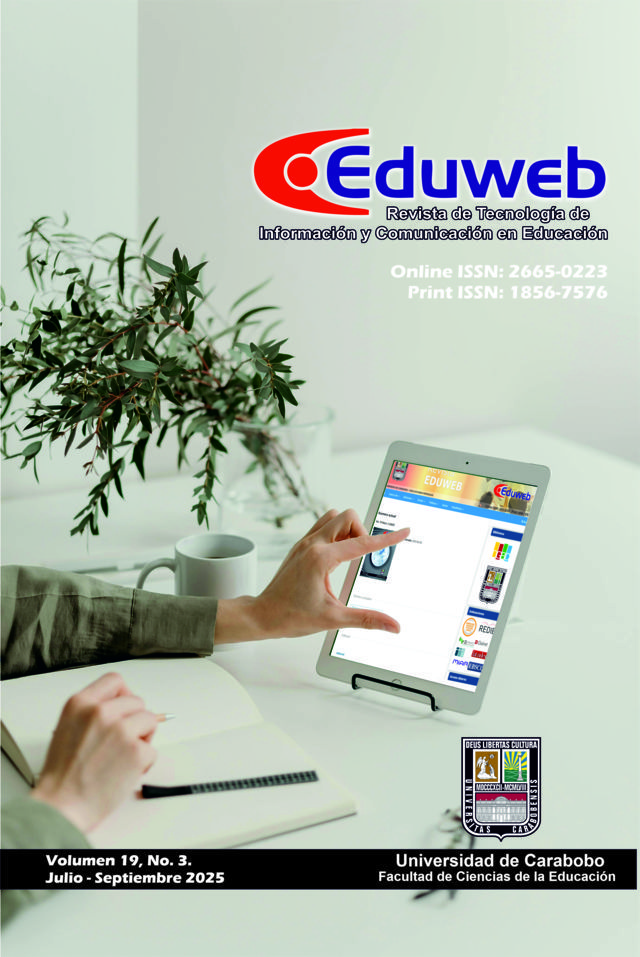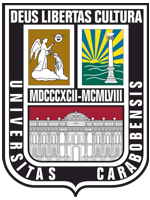Development of interactive virtual laboratories for distance learning in natural sciences
DOI:
https://doi.org/10.46502/issn.1856-7576/2025.19.03.10Keywords:
digital tools for education, distance learning, interactive virtual laboratories, natural sciences, simulationAbstract
The research investigates the existing interactive virtual laboratories used in distance learning in natural sciences, focusing on their functions, potentials, and limitations. To achieve this, a descriptive research design was employed, involving a comprehensive review of recent scientific publications, methodological resources, and institutional documentation related to the use of virtual laboratories within the educational process. The selected platforms were analyzed for their effectiveness in facilitating remote science education through interactive experiments, simulation of scientific phenomena, and visualization of complex concepts in biology, chemistry, and physics disciplines. Key features identified across all platforms include high interactivity, gamification elements, accuracy, and adaptability to users’ needs. The study also established criteria to assess the educational efficiency of these tools. A comparative analysis revealed the advantages (engagement, flexibility, and conceptual clarity) and the challenges, including technical limitations and the need for pedagogical assistance in distance learning in natural sciences. As a result, the research proposes specific organizational and instructional recommendations to support the effective implementation of virtual laboratories. The outcomes are particularly relevant for higher education institutions aiming to enhance the professional preparation of future specialists in natural sciences, particularly during crises when distance learning is more applicable.
References
Aliev, Y., Ivanova, G., & Borodzhieva, A. (2024). Design and Research of a Virtual Laboratory for Coding Theory. Applied Sciences, 14(20), 9546. https://doi.org/10.3390/app14209546
Banda, H. J., & Nzabahimana, J. (2022). The Impact of Physics Education Technology (PhET) Interactive Simulation-Based Learning on Motivation and Academic Achievement Among Malawian Physics Students. Journal of Science Education and Technology, 32, 127–141. https://doi.org/10.1007/s10956-022-10010-3
Bashkirova, L., Kit, I., Havryshchuk, Y., Krasnova, A., & Vasylyuk-Zaitseva, S. (2024). Artificial Intelligence in Medicine: from Diagnosis to Treatment. Futurity Medicine, 3(3). https://doi.org/10.57125/FEM.2024.09.30.07
Bati, V., Teslenko, D., Yuryk, O., Avtomieienko, Y., & Bashkirova, L. (2024). The role of clinical research in improving medical practice: from theory to practice. Salud, Ciencia y Tecnología – Serie de Conferencias, 3, 1132, https://doi.org/10.56294/sctconf2024.1132
Chen, P.-H. (2020). The design of applying gamification in an immersive Virtual Reality virtual laboratory for powder-bed binder jetting 3DP training. Education Sciences, 10(7), 172. https://doi.org/10.3390/educsci10070172
Donelan, H., & Kear, K. (2023). Online group projects in higher education: persistent challenges and implications for practice. Journal of Computing in Higher Education, 36(2), 1–34. https://doi.org/10.1007/s12528-023-09360-7
El Kharki, K., Berrada, K., & Burgos, D. (2021). Design and implementation of a virtual laboratory for physics subjects in Moroccan universities. Sustainability, 13(7), 3711. https://doi.org/10.3390/su13073711
Elkin, R. L., Beaubien, J. M., Damaghi, N., Chang, T. P., & Kessler, D. O. (2024). Dynamic cognitive load assessment in virtual reality. Simulation & Gaming, 55(4), 755–775. https://doi.org/10.1177/10468781241248821
Elmoazen, R., Saqr, M., Khalil, M., & Wasson, B. (2023). Learning analytics in virtual laboratories: a systematic literature review of empirical research. Smart Learning Environments, 10(1). https://doi.org/10.1186/s40561-023-00244-y
Gerlich, M. (2025). AI tools in society: Impacts on cognitive offloading and the future of critical thinking. Societies (Basel, Switzerland), 15(1), 6. https://doi.org/10.3390/soc15010006
Gligorea, I., Cioca, M., Oancea, R., Gorski, A.-T., Gorski, H., & Tudorache, P. (2023). Adaptive learning using artificial intelligence in e-learning: A literature review. Education Sciences, 13(12), 1216. https://doi.org/10.3390/educsci13121216
Gonzalez-Mohino, M., Rodriguez-Domenech, M. Á., Callejas-Albiñana, A. I., & Castillo-Canalejo, A. (2023). Empowering critical thinking: The role of digital tools in citizen participation. Journal of New Approaches in Educational Research, 12(2), 258–275. https://doi.org/10.7821/naer.2023.7.1385
Hassan, J., Devi, A., & Ray, B. (2022). Virtual Laboratories in tertiary education: Case study analysis by learning theories. Education Sciences, 12(8), 554. https://doi.org/10.3390/educsci12080554
Hudym, I., Abilova, O., Potapiuk, L., Nikolenko, L., & Poliakova, A. (2024). Strategies and best practices for promoting inclusive education to meet diverse learning needs. Conhecimento & Diversidade, 16(42), 270–286. https://doi.org/10.18316/rcd.v16i42.11682
Hulai, O., Shemet, V., Moroz, I., Savaryn, P., & Kabak, V. (2024). Using the labster virtual laboratory to study chemistry at a technical university. Information Technologies and Learning Tools, 102(4), 95-107. https://doi.org/10.33407/itlt.v102i4.5737
Iskakova, M. (2023). Electronic Technologies to Ensure Individual Learning of Education Seekers with Special Needs. Futurity of Social Sciences, 1(1), 4–20. https://doi.org/10.57125/FS.2023.03.20.01
Kikari, A. B., Mwisomba, C., Karawa, C. J., Salawa, J. S., & Ally, J. S. (2024). Development of biology virtual laboratory. East African Journal of Information Technology, 7(1), 167–172. https://doi.org/10.37284/eajit.7.1.2033
Klami, A., Damoulas, T., Engkvist, O., Rinke, P., & Kaski, S. (2024). Virtual laboratories: transforming research with AI. Data-Centric Engineering, 5(e19). https://doi.org/10.1017/dce.2024.15
Kok, Y.-Y., Er, H.-M., & Nadarajah, V. D. (2021). An analysis of health science students’ preparedness and perception of interactive virtual laboratory simulation. Medical Science Educator, 31(6), 1919–1929. https://doi.org/10.1007/s40670-021-01364-1
Kurebay, B., Seitenova, S., Khassanova, I., Kazetova, A., Bayukanskaya, S., & Mailybaeva, G. (2023). Competence of primary school teachers in the use of internet resources. International Journal of Education in Mathematics, Science, and Technology, 11(4), 964-980. https://doi.org/10.46328/ijemst.3466
Li, J., & Liang, W. (2024). Effectiveness of virtual laboratory in engineering education: A meta-analysis. PloS One, 19(12), e0316269. https://doi.org/10.1371/journal.pone.0316269
Lucenko, G., Lutsenko, O., Tiulpa, T., Sosnenko, O., & Nazarenko, O. (2023). Online - Education and training in higher educational institutions of Ukraine: Challenges and benefits. International Journal of Educational Research Open, 4(100231), 100231. https://doi.org/10.1016/j.ijedro.2023.100231
Matviichuk, L., Ferilli, S., & Hnedko, N. (2022). Study of the organization and implementation of E-learning in wartime inside Ukraine. Future Internet, 14(10), 295. https://doi.org/10.3390/fi14100295
Mayer, A., Yaremko, O., Shchudrova, T., Korotun, O., Dospil, K., & Hege, I. (2023). Medical education in times of war: a mixed-methods needs analysis at Ukrainian medical schools. BMC Medical Education, 23(1), 804. https://doi.org/10.1186/s12909-023-04768-2
Qawaqneh, H., Ahmad, F. B., & Alawamreh, A. R. (2023). The impact of artificial intelligence-based virtual laboratories on developing students’ motivation towards learning mathematics. International Journal of Emerging Technologies in Learning (iJET), 18(14), 105–121. https://doi.org/10.3991/ijet.v18i14.39873
Raman, R., Achuthan, K., Nair, V. K., & Nedungadi, P. (2022). Virtual Laboratories- A historical review and bibliometric analysis of the past three decades. Education and Information Technologies, 27(8), 11055–11087. https://doi.org/10.1007/s10639-022-11058-9
Reginald, G. (2023). Teaching and learning using virtual labs: Investigating the effects on students’ self-regulation. Cogent Education, 10(1). https://doi.org/10.1080/2331186x.2023.2172308
Ron-Valenzuela, P., Vargas, D., & Medina, L. (2022). Design of a virtual laboratory for practical learning of environmental management and industrial safety. In Communications in Computer and Information Science (pp. 205–212). Springer Nature Switzerland. https://doi.org/10.1007/978-3-031-19682-9_27
Sanzana, M. R., Abdulrazic, M. O. M., Wong, J. Y., Karunagharan, J. K., & Chia, J. (2023). Gamified virtual labs: shifting from physical environments for low-risk interactive learning. Journal of Applied Research in Higher Education, 16(1), 208–221. https://doi.org/10.1108/jarhe-09-2022-0281
Sapriati, A., Suhandoko, A. D. J., Yundayani, A., Karim, R. A., Kusmawan, U., Mohd Adnan, A. H., & Suhandoko, A. A. (2023). The Effect of Virtual Laboratories on Improving Students’ SRL: An Umbrella Systematic Review. Education Sciences, 13(3), 222. https://doi.org/10.3390/educsci13030222
Sellberg, C., Nazari, Z., & Solberg, M. (2024). Virtual laboratories in STEM higher education: A scoping review. Nordic Journal of Systematic Reviews in Education, 2(1), 58–75. https://doi.org/10.23865/njsre.v2.5766
Serrano-Perez, J. J., González-García, L., Flacco, N., Taberner-Cortés, A., García-Arnandis, I., Pérez-López, G., Pellín-Carcelén, A., & Romá-Mateo, C. (2021). Traditional vs. Virtual laboratories in health sciences education. Journal of Biological Education, 57(1), 36–50. https://doi.org/10.1080/00219266.2021.1877776
Shamshin, A. (2021). Detailed analysis of the advantages of virtual laboratory works in physics. ScienceRise Pedagogical Education, 3(42), 32–37. https://doi.org/10.15587/2519-4984.2021.233937
Simanca H, F. A., Palacios, J., Barbosa, L. M., & Quintero, C. D. B. (2024). Education without walls: The promise of virtual labs in the teaching process. Journal of Ecohumanism, 3(5). https://doi.org/10.62754/joe.v3i5.6654
Sipii, V., Deschenko, O, Honcharova, N., Hrytsenko, A., & Hrytsiuk, O. (2024). Analysis of the Prospects for the Development of Soft skills in Future education: Trends and Risk. Conhecimento & Diversidade, 16(44), 107–128. https://doi.org/10.18316/rcd.v16i44.12035
Södervik, I., Katajavuori, N., Kapp, K., Laurén, P., Aejmelaeus, M., & Sivén, M. (2021). Fostering performance in hands-on laboratory work with the use of mobile augmented reality (AR) glasses. Education Sciences, 11(12), 816. https://doi.org/10.3390/educsci11120816
Sypsas, A., & Kalles, D. (2023). Analysis, evaluation and reusability of virtual laboratory software based on conceptual modeling and conformance checking. Mathematics, 11(9), 2153. https://doi.org/10.3390/math11092153
Tiahunova, M. Y., & Lavryk, V. R. (2023). Virtual laboratory as an effective solution during distance education. Systems and Technologies, 66(2), 125-131. https://doi.org/10.32782/2521-6643-2023.2-66.14
Tsekhmister, Y., Konovalova, T., Bashkirova, L., Savitskaya, M., & Tsekhmister, B. (2023). Virtual reality in EU healthcare: Empowering patients and enhancing rehabilitation. Journal of Biochemical Technology, 14(3), 23–29. https://doi.org/10.51847/r5wjfvz1bj
Tsirulnikov, D., Suart, C., Abdullah, R., Vulcu, F., & Mullarkey, C. E. (2023). Game on: immersive virtual laboratory simulation improves student learning outcomes & motivation. FEBS Open Bio, 13(3), 396–407. https://doi.org/10.1002/2211-5463.13567
Turabay, G., Mailybaeva, G., Seitenova, S., Meterbayeva, K., Duisenbayev, A., & Ismailova, G. (2023). Analysis of intercultural communication competencies in prospective primary school teachers’ use of internet technologies. International Journal of Education in Mathematics, Science, and Technology, 11(6), 1537-1554. https://doi.org/10.46328/ijemst.3795
Vahdatikhaki, F., Friso-van den Bos, I., Mowlaei, S., & Kollöffel, B. (2023). Application of gamified virtual laboratories as a preparation tool for civil engineering students. European Journal of Engineering Education, 49(1), 164–191. https://doi.org/10.1080/03043797.2023.2265306
Wen, P., Lu, F., & Mohamad Ali, A. Z. (2024). Using attentional guidance methods in virtual reality laboratories reduces students’ cognitive load and improves their academic performance. Virtual Reality, 28(2). https://doi.org/10.1007/s10055-024-01012-0
Zhang, N., & Liu, Y. (2023). Design and implementation of virtual laboratories for higher education sustainability: a case study of Nankai University. Frontiers in Education, 8. https://doi.org/10.3389/feduc.2023.1322263
Zhao, X., Ren, Y., & Cheah, K. S. L. (2023). Leading virtual reality (VR) and Augmented Reality (AR) in education: Bibliometric and content analysis from the Web of Science (2018–2022). SAGE Open, 13(3). https://doi.org/10.1177/21582440231190821
Published
How to Cite
Issue
Section
License
Copyright (c) 2025 Valentyna Kolodii, Inna Koreneva, Nataliia Prokopenko, Oksana Huda, Yuliia Shaforost

This work is licensed under a Creative Commons Attribution 4.0 International License.














